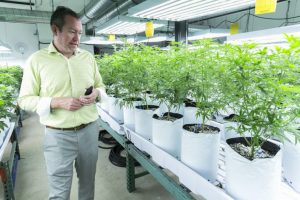What better time to explore free market economics than right now in Colorado. We are watching the growth and maturity of the commodity, cannabis, take shape at lightning speed. In the “free” market of Colorado, major investment money continues to flood in, production is on overdrive, giants are emerging using economies of scale and many are foreshadowing a future economists call “oligopoly”.
In two years the price per pound for wholesale flower has dropped by ⅔. The days of the $4,000 wholesale pound or the $499 ounce are gone and business owners are being forced to accept the fact that it is never coming back.
What market factors are creating such volatility?
Last week, the University of Denver released a report by Assistant Professor Paul Seaborn of the Daniels College of Business. Notable findings inside the report include:
- The Colorado Marijuana Enforcement Division has issued nearly 3,000 total marijuana business licenses, an increase of 70% from 2014.
- As of January 2016 Retail Marijuana Products Manufacturing Licensing issuance is up 40%, from 168 licenses to 236; Retail Marijuana Cultivation Facilities are up 22%, from 514 licenses to 625.
- The City and County of Denver have over 1/3 of the state’s active marijuana licenses at 1,244.
- The largest license holders in the state operating under a single name are Native Roots (62), LivWell (49), and SweetLeaf (34).
The data appears to indicate that the increase in cultivation facility licenses over the past year could be fueling the supply and demand dilemma many in the region attribute to the problem.
Many business owners, concerned about managing their operations on such tight profit margins, are starting to point fingers at the municipalities for potentially issuing too many licenses without instituting canopy restrictions. Possible evidence of this comes from the city of Denver, who narrowly passed Bill 16-0291, capping the total number of marijuana licences to 467. But was it too late?

“People are sitting on pounds of high-quality product because they can’t cover their costs in some situations at the current cost per pound,” describes Tim Cullen, CEO of Colorado Harvest Company. “Many grows, especially indoor grows, have high operating costs associated with them. It is tough to compete in this market with outdoor farms who have learned how to scale operations for 30 acres worth of equally high-quality product. When an indoor production tries to compete with an outdoor facility it will always cost more to run that indoor facility.”
The report shows some interesting findings, especially when one looks at the largest license holders. In order to maintain optimal margins, cultivators are being forced to obtain more licenses to achieve economies of scale and diversify their sales with products that make for better profit margins, like extracts and edibles. Integrated retail shops are being forced to push everything but flower in order to cover the costs to grow the flower. Another key data point that possibly confirms this in the study is the 40% spike in manufacturing licenses issued over the past year. The data indicates the need to diversify. The interesting part about that is how liberally the state decided to issue these permits.
Will the new supply inversely affect future prices on wholesale trim, extracts and oils as the market gets flooded, as we have seen with the flower market over the past 2 years?
What is a company to do?
The free market appears to be forcing everyone to innovate or get out of the way. This holds most true for retail shops with small- to medium-sized indoor grow operations. Many companies are achieving success and meeting their margins by investing in branding, being creative and focusing on their overall retail customer experience.
“Packaging and branding have never been more important in this industry,” said Jacob Kulchin, Managing Director of Denver-based Chiefton Design. “The bottom line is when you fight for shelf space in a market that is this competitive you must stand above the crowd and be remembered. We work tirelessly to help our clients achieve these goals.”
Jacob founded Chiefton Supply Co., a cannabis oriented apparel company for the new cannabis consumer market, in 2015. Following the company’s success he established Chiefton Design, a cannabis branding and design agency, in 2016. “Companies that were familiar with our apparel line wanted the same level of innovative branding and design to help differentiate themselves,” Jacob said. 
Chiefton Supply Co. and Chiefton Design are now part of the General Cannabis portfolio of companies.
“Vertical integration makes the Colorado market unique,” he explained. “We have true visionaries developing their products from seed to sale. Not only do the products deserve more than simple display behind a glass counter, or in an oversized jar, but customers now demand iconic and powerful design,” explains Kulchin.
The branding play makes sense. We have seen its power in other recreational product markets. Take the Starbuck’s approach to coffee, for example. Anyone can choose to grab a $1.00 cup of joe from their local cafe or diner. But they don’t. They choose to wait in line for the more expensive version. Logically and financially, it does not make sense. The only explanation as to why we do this is not a subject of rationality, but instead psychological human behavior. We all are inspired by the experience – the smiles, the smells and the feelings it all provokes. We go to Starbucks because of the experience, and the consistency of that experience is what keeps us returning. Going to a Starbucks to pay 900% more for a product that is widely available proves the power of branding and how much it impacts a recreational product market.
This is the scenario playing out in the Colorado cannabis market right now, particularly in Denver. We see tons of cheap, high quality product up and down the block. Business owners are fighting for foot traffic. Manufacturers are fighting for shelf space.
“Challenges with sales and marketing come with the territory,” said Cullen. “Retailers have a lot of options to deal with declining sales. For example, creating customer loyalty programs are one way to boost sales and build a brand. All too often we see many businesses take the low hanging fruit by cutting prices for a quick fix. Too many retailers are going down that path before exploring their other options.”
The growing pains of this regional market are sure to present themselves in new developing markets – like California, Nevada and Massachusetts. It may not appear immediately, but with time it will. The wise business owners and municipalities are going to do their homework and follow the trends to prepare for their own regional success. Colorado has paved the way in so many positive instances, but right now many people are taking it on the chin, being the guinea pigs.
“If cannabis companies want to survive the consolidation that is currently happening in the Colorado market, they must build original and compelling brands that cultivate loyal customer bases,” said Kulchin.
The U.S. Cannabis Spot Index has indicated some stabilization – as predicted – as the winter/holiday season is upon us; this may be short-lived as spring and summer return. Some analysts have predicted that the price of Colorado wholesale cannabis could continue to drop, with whispers of as low as $700 per pound being circulated. If the community does not get creative as a group and understand the implications of those prices, the last ones standing will be a handful of giants who had the capital and foresight to wait out the storm, only to control most of the market, eventually raising the prices back up to the margins that they choose through distribution.
What will the result of the Colorado free market cannabis experiment be? Diversity or Big Cannabis? That is up to the entire community to decide.







All that dirty dope money and the cultivation of clean business and the poor pure Wall Street banks are not part of it. Hooray Hooray for honest business right before mine very eyes. Good night Wall Street sleep good. Without the banks (WS types that is) we do not need their savior the FDIC! Hahaha.